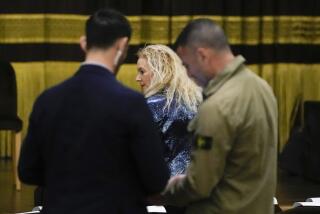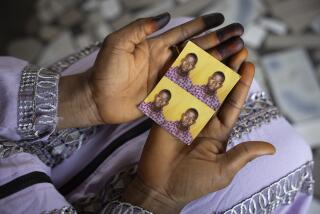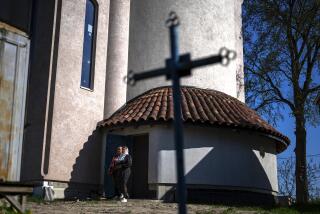Italy continues rescue efforts amid quake devastation
- Share via
ONNA, ITALY — The calls from America kept coming but Paolo Paolucci’s answer stayed the same:
“Gabriella is dead.”
A sigh, a gasp, and in the near distance Tuesday, the sounds of hands and clawed machines digging at the stone, mortar and splintered wood of broken homes and crumpled bell towers scattered for miles in eerie heaps beneath mountains thick with snow.
Paolucci’s elderly mother and sister, Gabriella, were two of the deceased as the toll from Monday’s magnitude 6.3 earthquake rose to 228. Eleven people remained missing.
Sniffer dogs barked and scurried, coffins waited, and blue and white tents rose in fields and stadiums to house more than 17,000 left homeless in the Abruzzo region, where winter lingered in the hills and the flatlands were tinged with the pink and white blooms of spring.
No place was hit as hard as Onna, which lost at least 40 residents and most of its beige and curry-colored tile roof buildings.
“Only a few houses are still standing. They’ll have to knock everything down,” said Ugo de Paudis, a town councilman, who stood in matted grass and mud as townspeople ate donated pasta off plastic plates. “That’s why we need to rebuild right here immediately, so there’s a sense of future. Otherwise, people will move in with their families in other villages and cities and our community will be lost.”
Yet even before the ground shook, ripping streets and shattering the 16th century statue of the Ascending Madonna, this map smudge of 350 people was diminishing year by year; families moving away, the young seeking their fortunes beyond the beet fields and tiny factories. It was a fate shared by hundreds of Italian towns and villages, but the quake may have hastened what some in Onna predicted was coming: the demise of a way of life that to a passerby once looked so sturdy, quaint and pretty.
Italian Prime Minister Silvio Berlusconi visited the region and, according to the ANSA news agency, told the displaced, “We won’t leave you alone. Don’t worry, the reconstructions will be quick.”
Carlo Ludovici, a gray-haired contractor whose clothes were heavy with the dust from his battered house, said he couldn’t bear the prospect of starting over again. He walked in the sunlight past a grazing horse and six smashed cars that looked to have been trampled underfoot by a giant dragon. He teared up, looked away.
“It’s a small village razed to the ground,” he said. “I started working when I was 16, but this tragedy has left me without the will to work anymore. Life is tough when you get to be 64, and you don’t think the earth will rumble or you’ll see bodies of young dead kids.
“There’s almost been a death in every house. It’s not the life you’d expect. I’d like to move away from it all, go deep into the mountains and become a hermit.”
Many of those who died in Onna were children or young adults. They had been baptized in St. Peter and the Apostles Church, just off Via Alfieri, and they were awaiting the coming Good Friday veneration when Father Cesare leads the procession of the cross through the narrow streets a few hundred yards off the big road that runs along the train tracks toward the heavily damaged medieval city of L’Aquila.
This year there is only rubble; families sitting under trees and tarps, a girl scratching her bandaged eye, a woman in a bathrobe wandering outside in the middle of the day, a cat peeking from the window of a car crammed with blankets and possessions.
Dogs pawed at the debris of a house whose buckled and exposed pastel bedroom walls shone oddly in the sun. The digging machine suddenly stopped. Townspeople and rescue workers in florescent vests gathered; maybe a twitch of life in a crevice. The dogs and their handlers retreated. Nothing. Those on tiptoes turned away with no news.
“They wouldn’t be using heavy machinery if there were more survivors,” said Maurizio Teofili, the director of a K-9 unit.
Alessandro Fiumara walked across the field with a painting. It was titled “Angelic Music” and depicted an angel hovering amid musical notes above a fortress. He had pulled it unscathed from his uncle’s house, and he wondered how it could escape damage when so much else was marred, when the earth has rippled with nearly 300 aftershocks, including one Tuesday evening with a magnitude of 5.5 to 5.7.
“It’s a miracle this picture survived,” he said. “My uncle and his wife are fine, but their two daughters died. It would have been better if the painting had been destroyed and they would have lived.”
He turned and looked at the remaining skyline of the village. Ragged, like an unearthed artifact, it rose no more than a few stories, dusty and slumping against mountain shadows and the faraway snow. His family is from Onna, but they left for Rome when he was a child. He comes back summers and Christmases.
“I don’t believe in miracles after this,” he said. “Life here used to be wonderful. Ninety-year-old people riding bikes and working in the fields. But now some of the next generation has been taken, and when you lose that. . . . This is not like when you have an earthquake in California or Los Angeles. There is no money here to rebuild.”
Paolo Paolucci slipped out of the sun and into the shade of a camper. He crossed his legs and ate pasta. His white hair hung shaggy over his brow. His voice was cracked and tired; he answered questions about the church he cares for and the families of Onna. Some of his uncles and cousins moved away decades ago to America. Everyone remembers those times -- emigrants streaming out of hill towns and clambering aboard boats to build cars in Michigan and raise skyscrapers in New York.
Paolucci stayed. He watched, kept the pews clean, the altar buffed.
“When the earthquake happened I had to gather my senses,” he said. “I called my mother but no one answered the phone. I went out and dug four people out of the ruins. We left the dead to help the screaming.”
His cellphone rang. It was an uncle in Detroit.
A pause.
“Gabriella is dead.”
Sometimes there’s nothing more to say.
--
Times staff writer Maria De Cristofaro in Rome contributed to this report.
More to Read
Sign up for Essential California
The most important California stories and recommendations in your inbox every morning.
You may occasionally receive promotional content from the Los Angeles Times.











